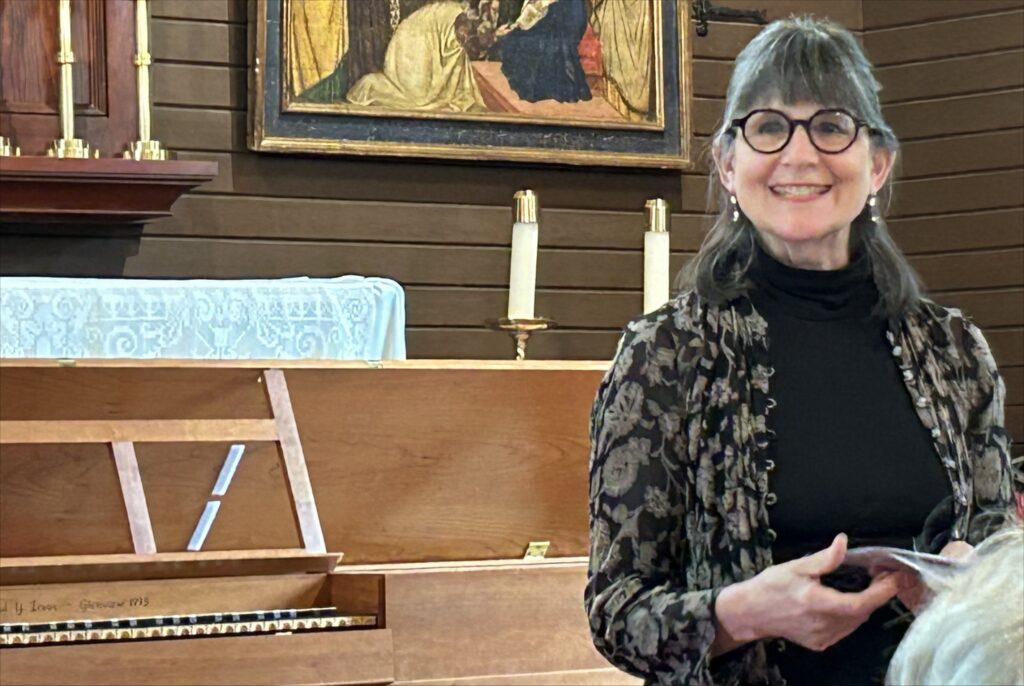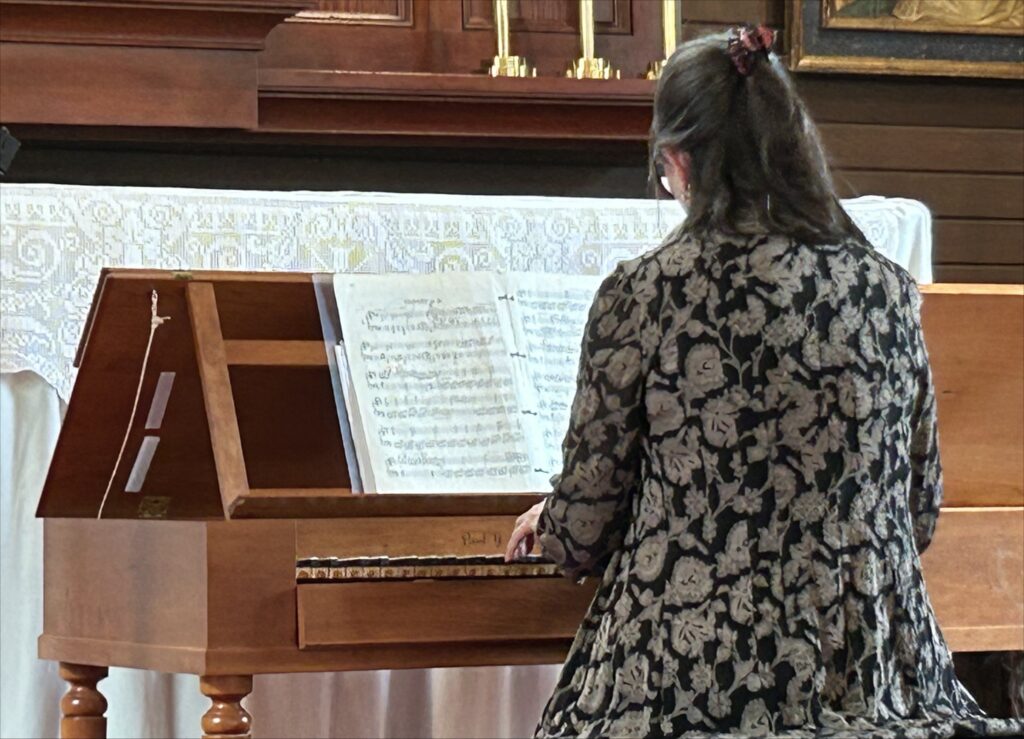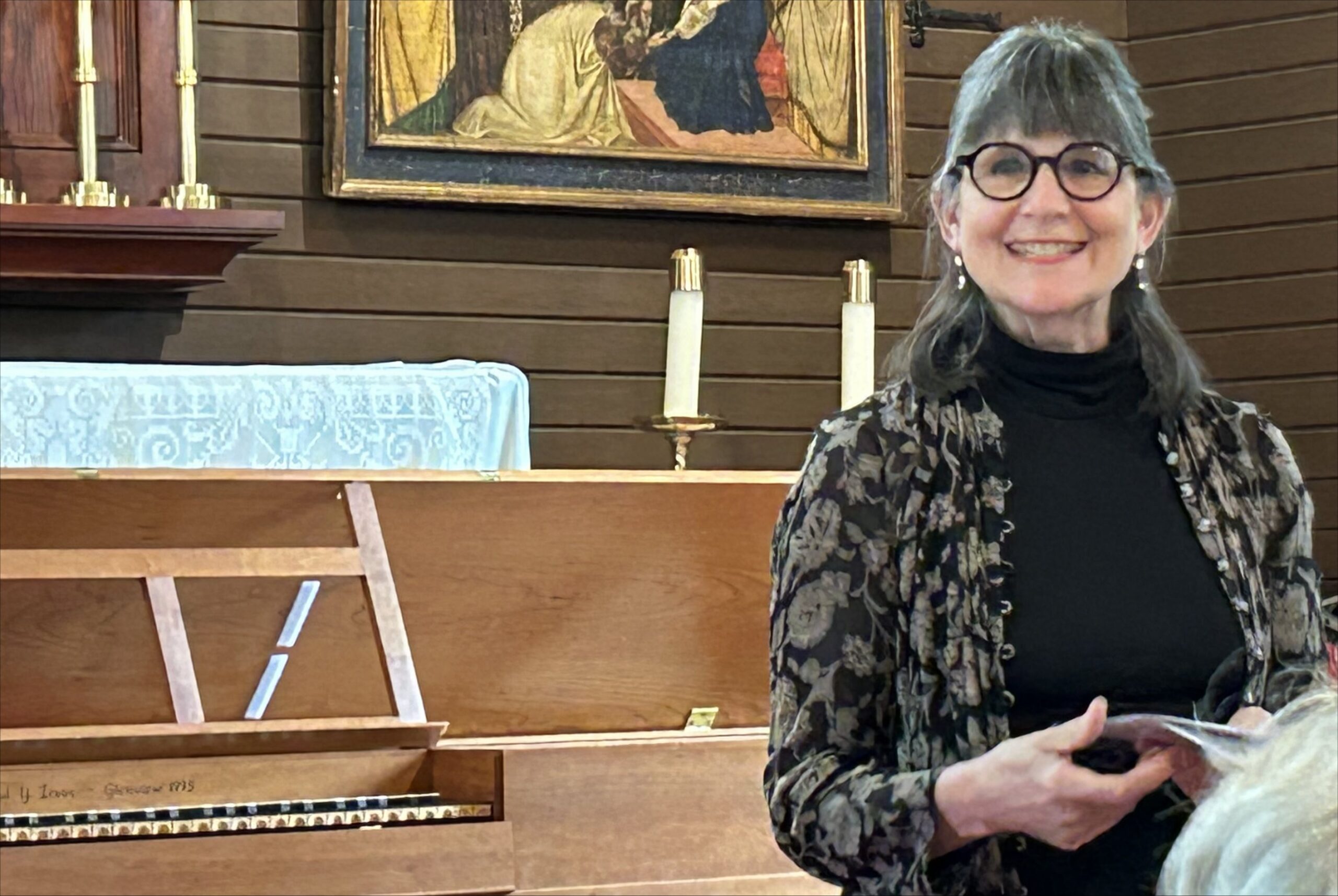Read More About the Event | Watch the Recital | Printable Program

Ascension Episcopal Parish, in the hills of Southwestern Portland, provided a cozy and warm ambiance for Marcia Hadjimarkos’ clavichord program of English-based music on April 20, 2024. Far-ranging in chronology, from 17th-century English virginal music through contemporary music specifically written for clavichord, Hadjimarkos captivated the appreciative audience with her elegant style and expressive playing.
Six anonymous pieces from Priscilla Bunbury’s Virginal Book (c. 1630) opened the program: The White Ribbon; Put Up Your Dagger, Jamie; Mrs. Priscilla Bunbury hir Delight; Birch and Green Holly; George; and The Friend’s Good-Night. All the pieces featured homophonic texture – treble melody with a simple harmonic accompaniment. Most expressive were the sweet melody of Birch and Green Holly, George of lively temperament, and a contemplative Friend’s Good-Night.
Next appeared four compositions of (primarily) Classical style. Johann Christian Bach’s Sonata in E-flat Major, Op. 5, No. 4, written in London in 1766, exuded Mozartean flavor. Often referred to as “the London Bach,” Johann Christian was the 18th child of Johann Sebastian. After his father died in 1750, 14-year-old Christian finished his musical education with his older brother Carl Philipp Emanuel Bach in Berlin. Later, he spent several years in Italy, soaking up the popular Galant style. When he moved to London in 1762, his engaging compositions attracted eager audiences. He is said to have been the first to play a recital – in 1768 — on a square piano. The clavichord’s dynamic possibilities, then, provide an appropriate medium for his music.
J.C. Bach’s Sonata Op. 5, No. 4 certainly presents an entertaining Galant style, with its vocal melodies, simple chordal accompaniment, occasional lively runs, and contrasting dynamics. A two-movement composition, the Rondo projected a sweet innocence.
The succeeding two composers ga ve us a taste of early Romanticism, yet within the bounds of Classical structure. George Frederick Pinto’s (d. 1806) dramatic Rondo in E-flat Major featured fuller textures, along with greater harmonic and expressive contrasts. The couplets particularly unleashed some stormy and shocking moments, almost Schubertian in their drama.
Maria Hester Park’s (d. 1813) Sonata in F Major, Op. 4, No. 2, from 1790 was also fascinating in its dramatic contrasts. The two-movement work’s Minuetto had a sweet, sentimental effect. Hadjimarkos’ well-controlled closing decrescendo to a pp was especially beautiful.
Joseph Haydn’s Sonata in D Major, H. XVI:51, was written late in his life during one his trips to London (1794), where the style of piano playing and composition was more flamboyant than that of Vienna. We can certainly find many of these elements in this sonata, having fuller textures and virtuosic parallel 3rds/6ths, all well executed by Hadmijarmos. I also appreciated the elegance she brought to the entire 2-movement sonata. One usually hears Haydn’s keyboard works played on piano; however, given his lifelong association with clavichord, I enjoyed hearing this more intimate rendition, such as Haydn himself may have enjoyed in his own sitting room.
The final two compositions were by contemporary composers, and written specifically for the clavichord. Three pieces from Herbert Howells’ (d. 1983) Lambert’s Clavichord (1927), a collection inspired by his friendship with the harpsichord and clavichord builder Herbert Lambert of Bath, exploited subtle and contrasting dynamic qualities of the clavichord, as well as reminiscences of earlier virginal music. In Lambert’s Fireside, Hadjimarkos’ subtle dynamics well brought out the intimate and expressive nature of a glimmering fireside, while Sir Hugh’s Galliard offered up a spirited style under Hadjimarkos’ nimble fingers. Lastly, in De la Mare’s Pavane, interesting interplays of minor, major, and phyrygian modes, and a wide range of subtle and contrasting dynamics fully exploited the clavichord’s expressive capabilities.
Concluding the program, Graham Lynch’s (b. 1957) Petenara, Four Pieces for Clavichord, composed in 2005, ushered us into a fascinating tonal world in which traditional structures of harmony, meter, and form have been left behind, in favor of free improvisatory effects. Hadjimarkos excelled in these pieces: Bell (Bass String), with riveting long pauses and an ostinato bell tolling; The Six String’s ostinato and improvisatory phrases; Dance’s perpetual motion and whirlwind effect; and De Profundis’ three-note descending bass ostinato and spontaneously contrasting sections.
The clavichord used for this program was an unfretted 5-octave instrument after Christian Gottfried Friederici of 1765, built by Paul Irvin in 1995 for Carol lei Breckenridge. It has been strung in Stephen Birkett’s historical wire, and has had extensive adjustment and voicing over the years. It possesses a quite robust tone, long sustain, and superb clarity in all its ranges. Marcia Hadjimarkos’ well controlled and elegant playing elicited from the instrument tones that rang through the parish chapel and into our hearts.

